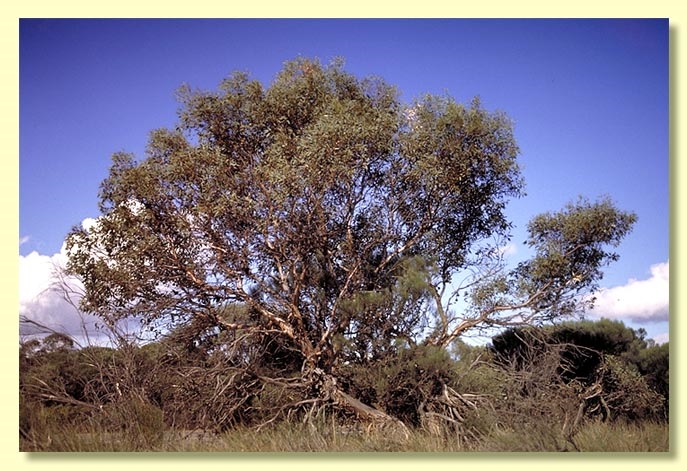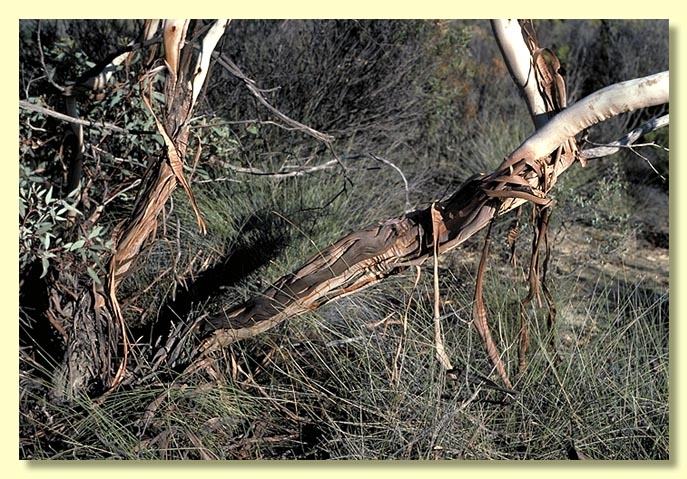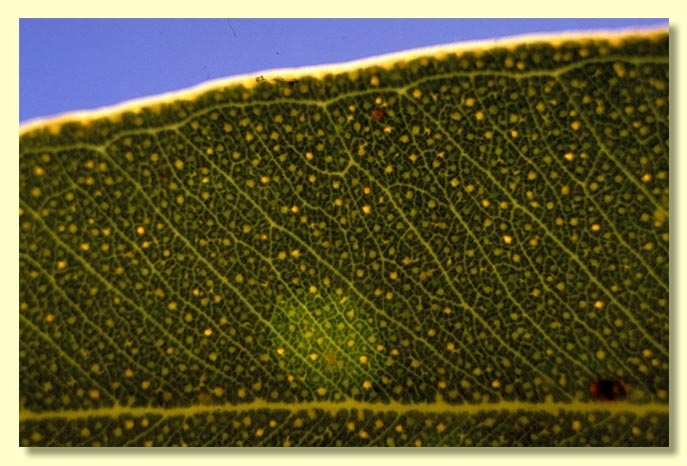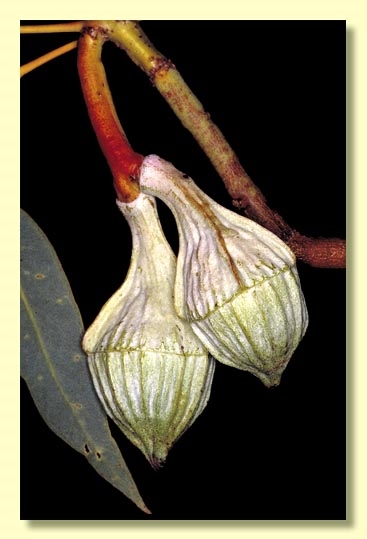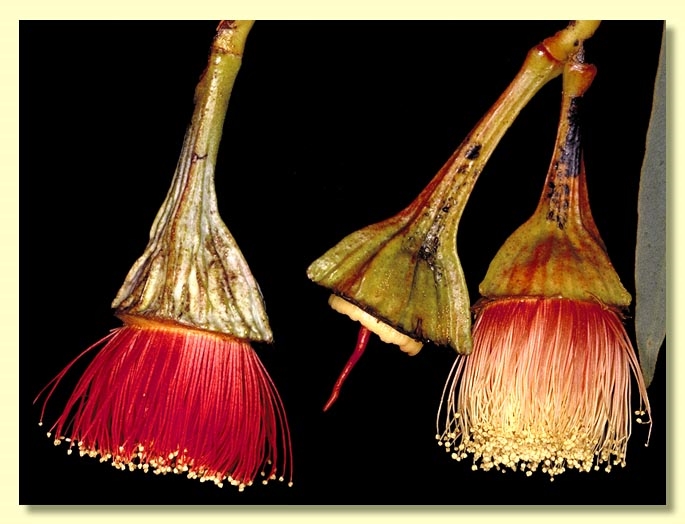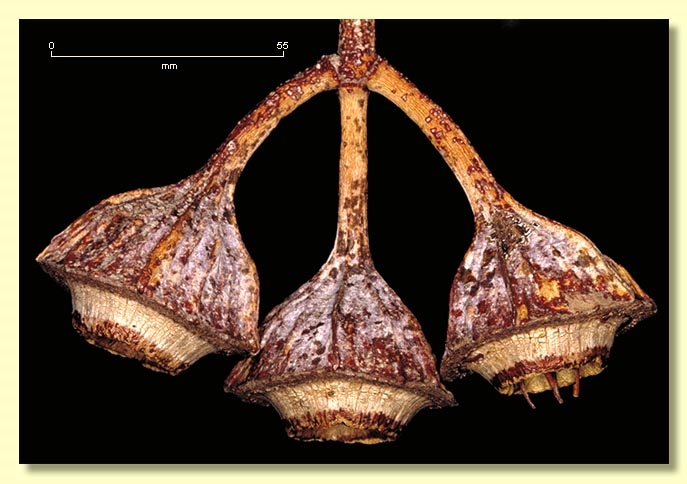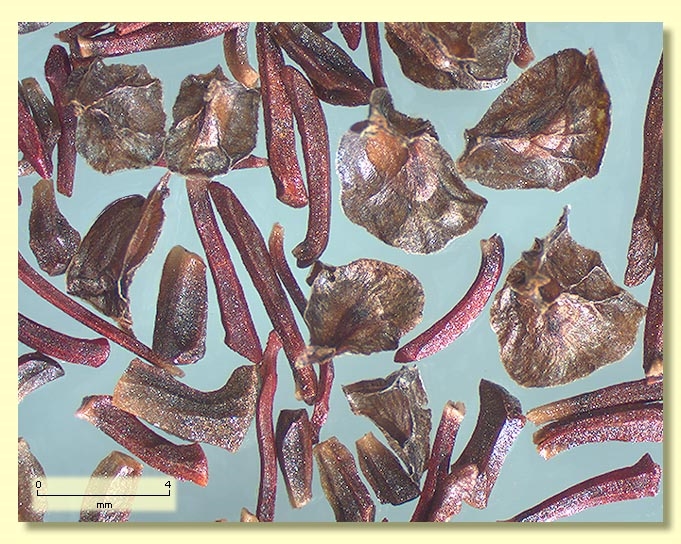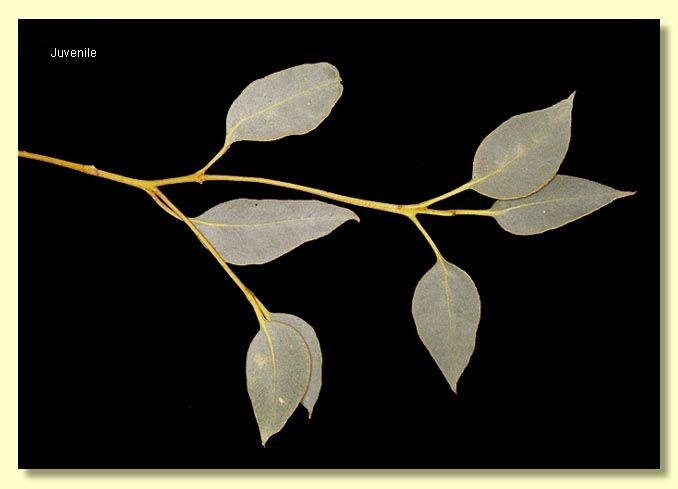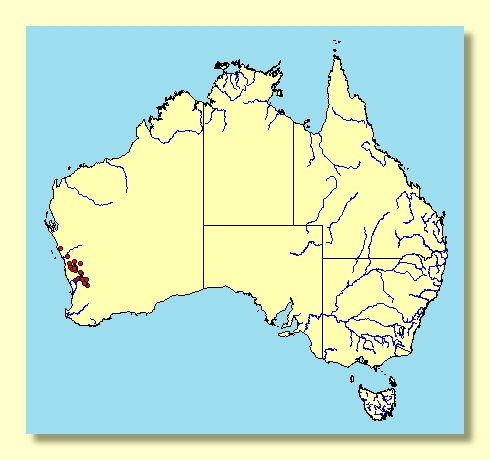Euclid - Online edition
Eucalyptus pyriformis
Eucalyptus | Symphyomyrtus | Bisectae | Destitutae | Curviptera | Xylocarpae
T: Swan R. Colony, W.A., J.Drummond 4: 69; holo: KW; iso: BM, K, MEL.
Eucalyptus pruinosa Turcz., Bull. Soc. Imp. Naturalistes Moscou 22(2): 23 (1849), nom. illeg. non Schauer (1843); E. macrocalyx Turcz., Bull. Cl. Pys.-Math. Acad. Imp. Sci. Saint-Petersburg 10: 339 (1852) based on E. pruinosa Turcz. T: Swan R. Colony, W.A., J.Drummond 4: 70; iso: K.
Eucalyptus erythrocalyx Oldfield & F.Muell. ex F.Muell., Fragm. 2: 32 (1860). T: between Port Gregory & Murchison R., W.A.; A.F. Oldfield; holo: n.v.; iso: K.
Eucalyptus pyriformis var. elongata Maiden, Crit. Revis. Eucalyptus 2: 235 (1912). T: between Lawlers & Doyles Well, W.A., June 1901, W.V.Fitzgerald s.n.; holo: NSW; iso: K.
Bark smooth throughout or with a short stocking of persistent ribbony grey-brown bark, smooth bark grey-brown shedding to light brown or reddish grey.
Branchlets lacking oil glands in the pith.
Juvenile growth (coppice or field seedlings to 50 cm): stems rounded in cross-section, glaucous or non-glaucous; juvenile leaves always petiolate, alternate, ovate to broadly lanceolate, 4–7 cm long, 3–4.5 cm wide, dull, bluish green or slightly glaucous.
Adult leaves alternate, petioles 1–3 cm long; blade ovate to lanceolate, 5.5–9.5(11) cm long, 1.5–3 cm wide, base tapering to petiole, margin entire, apex pointed, concolorous, dull, blue-green, side-veins greater than 45° to midrib, reticulation dense, intramarginal vein close to margin, oil glands irregularly-shaped, intersectional.
Inflorescence axillary unbranched, pendulous, peduncles stout, (1.2)2–11.5 cm long, buds 3, pedicellate (pedicels 2.5–6.5 cm long). Mature buds ovoid (3.2–6 cm long, 2–3 cm wide), rarely globular, glaucous or non-glaucous, longitudinally ribbed, scar present, operculum beaked (1.5–3.2 cm long), seldom rounded and apiculate, outer stamens oblique, inner stamens inflexed, anthers cuboid, versatile, dorsifixed, dehiscing by longitudinal slits, style long and usually straight, stigma tapered, locules 4 or 5(6), the placentae each with (8)10 and sometimes more vertical rows of ovules with a central gap to the placenta, rarely the ovules very numerous and rows indistinct. Flowers have red, pinkish red or yellow staminal filaments, anthers always yellow.
Fruit on rigidly down-turned peduncles, pedicellate (pedicels 1.5–6 cm long), usually obconical, sometimes glaucous, always with several prominent longitudinal ribs, 2.5–4 cm long, 3–5.5 cm wide, disc cream-coloured, concave and prominently raised then steeply descending to throat of capsule, valves 4 or 5(6).
Seeds brown, 3–6 mm long, obliquely pyramidal with prominent ridges and an asymmetrical more or less encircling marginal flange, dorsal surface smooth to shallowly reticulate, hilum terminal.
Cultivated seedlings (measured at node 10): cotyledons Y-shaped (bisected); stems rounded in cross-section, glaucous or not; leaves always petiolate, opposite for 4–8 nodes then alternate, deltoid, ovate or broadly lanceolate, 5.5–9 cm long, 4–5.5 cm wide, base truncate or tapering, apex pointed or rounded, dull, grey-green to slightly glaucous.
Flowering has been recorded in May, July, August, September and November.
A low straggly mallee endemic to Western Australia, found in the western side of the northern wheatbelt north-east and north of Perth, from Dowerin to Morawa, with a few localities north of Geraldton. Its earlier supposed occurrence in South Australia was due to confusion with E. youngiana. The stems are smooth with much ribboning and adult leaves are dull, grey to grey-green.
Eucalyptus pyriformis belongs in Eucalyptus subgenus Symphyomyrtus section Bisectae subsection Destitutae because buds have two opercula, cotyledons are Y-shaped and branchlets lack oil glands in the pith. Within this subsection E. pyriformis is in series Curviptera, one of about 30 closely related species and subspecies which are further characterised by having large buds in umbels of one, three or seven, staminal filaments erect or oblique (rarely inflexed) in bud, and large fruit usually with an ascending disc and exserted valves. Several of these species are noted for their large-leaved crowns made up of juvenile leaves.
E. pyriformis is easily distinguished from other species in the area by its large down-turned buds in umbels of three, stoutly stalked obconical ribbed fruit to 5.5 cm wide, red, pink or white flowers and petiolate juvenile leaves.

